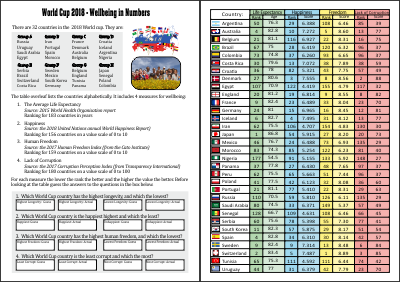
All human beings should try to learn before they die what they are running from, and to, and why.
James Thurber (1894-1961)
World Cup 2018 - Wellbeing in Numbers
All that I know most surely about morality and obligations I owe to football.
Albert Camus
 This sheet offers practise at pulling out information from a table of statistics. It is also intended to get students thinking about wellbeing and the living conditions in different countries.
This sheet offers practise at pulling out information from a table of statistics. It is also intended to get students thinking about wellbeing and the living conditions in different countries.
Suggested Procedure:
Start by asking the class who is interested in the World Cup. Tell the students there are 32 countries in the World Cup divided into 8 groups of four. How many countries can the students name and group? With a small class give them a couple of minutes to call out the names and write them in groups on the board. With a large class have the students work in groups of 3-4 for a couple of minutes before writing up the names. Leave a space at the top of the board to write the word "wellbeing".
Next ask the students to share moments when they were happy. Share one of your own. Then write the word "wellbeing" at the top of the board and ask the students what they understand about the word and if they can think of any differences between wellbeing and happiness. Again with a large class give the students a couple of moments to discuss their ideas before sharing them with the whole group.
Show the students the sheet and tell them not to look at the colourful table but focus on the front page. Hand out the sheets and go through the front page together. Explain any new vocabulary. Then tell the students to write down their 8 guesses to answer to the four questions:
- Which World Cup country has the highest longevity, and which the lowest?
- Which World Cup country is the happiest highest and which the least?
- Which World Cup country has the highest human freedom, and which the lowest?
- Which World Cup country is the least corrupt and which the most?
Go through some of the guesses and ask students to come up with reasons to support or deny a suggestion. Finally tell students to flip the sheet over and find the correct answers.
Follow Up
Ask the students questions and get them to call out the answers. Here are a few suggestions (answers in brackets):
- Which country is ranked after Japan for life expectancy? (Switzerland)
- Which country has a life expectancy of 75? (Brazil).
- What is the life expectancy for the host nation? (70.5)
- Which country has a happiness ranking of 13? (Costa Ricca)
- Which country has a happiness score of 6.260? (Columbia)
- Which countries have a freedom ranking of 22 (Belgium and Portugal)
- Which country has the same ranking for happiness and freedom? (Tunisia)
- What's the difference in freedom score between England and Japan (0.35)
- How many countries have a lack of corruption score of 40 or less? (10)
- How many countries have a lack of corruption score above 90? (none)
Can the students come up with questions of their own for each other or for the teacher?
Notes:
The figures for England are actually for the United Kingdom as a whole. The country with the lowest life expectancy in the World is Sierra Leone (50.1 years). The happiest country in 2018 is Finland. The least happy is Burundi with a rating of 2.905. The least free country is Syria with a rating of 4.04. Corruption is defined as "the abuse of entrusted power for private gain". The least corrupt country is currently New Zealand with a rating of 89. The most corrupt is Somalia with a score of 9. North Korea is currently ranked 171 with a score of 17. The United States is ranked 16 with a score of 75. Freedom-wise the US is ranked 17 with a score of 8.39 and people there are slightly happier than in the UK (rank 18 with a score of 6.886). The average life expectancy in the US is 79.3 (rank 31).
There are two files to download. The first contains the sheet alone. The second, larger file contains the sheet and different versions of the data table with gaps. These can be printed instead of the main table or in addition. It is of course possible to skip side 1 of the sheet and just fill in the gaps.
Open for comments! Please send suggested improvements to these notes or the sheet itself.
Last revision June 2018
getfile: World Cup 2018 Wellbeing
Wellbeing Basic Sheet:PDF B5 Size, 2 pages (3.11 mb) Wellbeing Sheets with Gaps:
PDF: B5 Size, 14 pages (12.6 mb)
- Top Page
- Splog!
- Articles
- Games
- Across The Table
- Add One More
- Anaconda
- Be A Monster!
- Black Hole (board game)
- Bombs Away!
- Catch!
- Catch-Caught-Caught!
- Centipede
- Charades
- Co-operative Quiz
- Crocodile
- Dice Stack
- Fast Food Tag
- Find My Number
- Find The Penny
- Football
- The Happy Game
- Line Up!
- Maze Challenge
- Natty Narration
- Nose Nose Nose
- One Step Forward!
- Pair Fluency Match 7 - Death Wish
- Pair Fluency Match 7 - Go Green!
- Parrot Parade
- Passport Control
- Reach The Top!
- Snake
- SockIt!
- Tickle Time
- What Cards
- Which One?
- Whose Shoe?
- World Cup Football 2018
- You, You, Me!
- Wake Up
- Packs
- Sheets
- Songs and Music
- Strips (songs and otherwise)
- Stories
- Techniques
- Video
- Environment
- Japan
- The 75th Anniversay of the bombing of Hiroshima
- The 75th Anniversay of the bombing of Nagasaki
- Cars in Japan
- Coronavirus Olympics
- Forest Bathing
- Japan and the Summit
- Japan and World War Two
- Multiculural Japan?
- Olympics Two Tokyos
- Plastic in Japan
- Return to Fukushima
- The Anniversary too Important to Cancel
- Typhoon Jebi
- Yayoi Kusama's Infinity
- Other
- This Week In History
- January, February, March
- April, May, June
- Sub Menu Item
- This Week in History: April 8-10
- This Week in History: April 12-15
- This Week in History: April 19-24
- This Week in History: April 24-26
- This Week in History: May 6-11
- This Week in History: May 11-14
- This Week in History: May 18-23
- This Week in History: May 25-31
- This Week in History: June 1-5
- This Week in History: June 11-14
- This Week in History: June 22-27
- This Week in History: June 15-21
- This Week in History: June 29 - July 5
- July, August, September
- This Week in History: July 6-12
- Sub Menu Item
- This Week in History: July 14-19
- This Week in History: July 27-31
- This Week in History: August 2- 6
- This Week in History: August 17-21
- This Week in History: August 27-30
- This Week in History: August 31 - September 6th
- This Week in History: September 7-13
- This Week in History: September 22-27
- This Week in History: September 14-20
- This Week in History: September 28 - October 4
- October, November, December
- Quizes
- Vocab




Post A Comment
All comments and questions will be added provided they are on topic in some way and have content. Praise or disdain without explanation will probably be ignored.
Spam will be binned.
Email Addresses submitted with comments will not be published, bought, sold, traded or used in anyway except for direct personal replies.